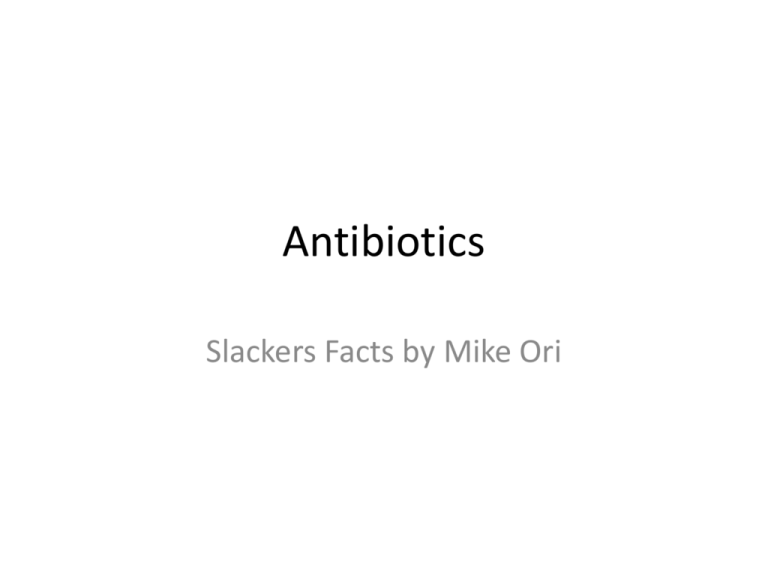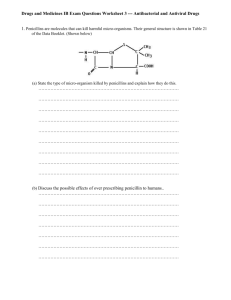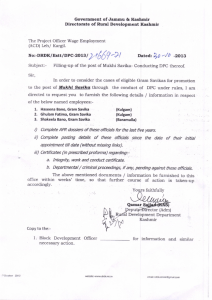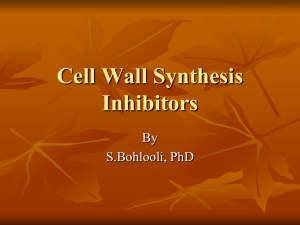Immunology Stack
advertisement

Antibiotics Slackers Facts by Mike Ori Disclaimer The information represents my understanding only so errors and omissions are probably rampant. It has not been vetted or reviewed by faculty. The source is our class notes. The document can mostly be used forward and backward. I tried to mark questionable stuff with (?). If you want it to look pretty, steal some crayons and go to town. Finally… If you’re a gunner, buck up and do your own work. What are the types of beta lactam antibiotics Penicillins Cephalosporins Carbapenems Monobactams Name the classes of penicillins Standard Antistaphylococcal Amino Antipseudomonal What are the anti-staph penicillins and their routes Nafcillin - IV Dicloxacillin - PO What are the standard penicillins and routes Penicillin V – PO Penicillin G - IV Which bacteria are exquisitely sensitive to standard penicillins Group A strep (pyogenes) Amino penicillins names and routes Ampicillin – PO,IV Amoxicillin – PO What is typically coadministered with the aminopenicillins Beta lactamase inhibitors Amoxicillin – clavulanate Ampicillin - sulbactam What is the CSF action of aminopenicillins Can reach CSF if the meninges are inflamed What side effect can happen when giving aminopenicillins to pt with infectious mononucleosis, chronic lymphocitic leukemia, allopurinol Rash Lowest incidence with allopurinol, others are very high. Cephalosporins names, generation, routes, and gram positive/negative effectiveness Generation Route Positive Negative Cefazolin 1 IM, IV +++ + Cephalexin 1 PO None tested 2 ++ ++ Ceftriaxone 3 IM, IV ++ +++ Ceftazidime 3 IM, IV Cefepime 4 IM, IV +++ +++ Susceptibility by generation. General trend is down with gram positives and up with gram negatives. Which generation reaches effective levels in the CSF Third gen Your patient has an allergy to penicillin G can you administer cephalosporins Maybe. Contraindicated if the pt experienced an IgE mediated rash. Caution with other penicillin type reaction. Carbapenems names, routes, and spectrum Imipenem, IV Broadest range of all available antibiotics. Excellent penetration through porins into gram negative periplasmic space What is cilastin A drug coadministered with imipenem to inhibit kidney ezymes that breakdown imipenem into nephrotoxic metabolites Imipenem ADR Seizures Monbactam names, routes, spectrum Aztreonam, IV gram negatives including P aeruginosa. Ineffective against gram positives or anaerobes Glycopeptides name, route, spectrum Vancomycin, IV, Gram positives only Vanco has poor oral availability so why do the dosing instructions include oral administration? Vanco is useful for treatment of gram positive anaerobic infections of the GI tract such as C. difficile infections. Describe the ADR from rapid infusion of vancomycin Rapid infusion results in histamine release that cause flushing of the skin of the neck and upper trunk that can result in hypotension. AKA red man or red neck syndome List the protein inhibitory antibiotic classes and their action Aminoglycosides – 30s Macrolides – 50s Lincosamides – 50s Tetracyclines – 30s Chloramphenicol – 50s Streptogramins – 50s Oxazolidinones – ribosome assembly Aminoglycoside names, routes, spectrum Gentamicin, IV Tobramycin, IV Both are effective against aerobic gram negative and mycobacterium Aminoglycoside toxicity characteristics Nephrotoxic and ototoxic above an patient variable threshold in time dependent manner Aminoglycoside dosing characteristics Concentration dependent killing with significant post antibiotic effect allows for once daily dosing. Note: This contrasts to most others that are both time and concentration dependent. Why are aminoglycosides ineffective against anaerobic bacteria? Entry into the cell is mediated by oxygen dependent transport. Aminoglycoside resistance basis Transferase enzymes inactive them. Unlike penicillins, there are variations in the resistance enzymes. Aminoglycoside toxic trough threshold Trough concentrations above 2 mcg/mL are predictive of toxicity Macrolide names, route Azithromycin, PO (Z pack), IV Azithromycin indications Treatment of out of hospital community acquired respiratory infection and in hospital pneumonia in combination. STD’s Macrolide CSF penetration characteristics Poor Azithromycin volume of distribution Extremely high volume of distribution with tissue concentration 10-100x plasma. Azithromycin half life 2-4 days Primary azithromycin caution Caution in PT with prolonged QT interval due to risk of torsades des pointes Lincosamides name, route, spectrum Clindamycin, PO,IV, strep, staph, anaerobes Clindamycin indications Anaerobes above the diaphragm Clindamycin associated disease C-diff enteritis Tetracycline name, route, spectrum Doxycycline, PO, IV, Chlamydia, mycoplasma, spirochetes Tetracyclines contraindication Children and pregnant or breastfeeding women due to staining of developing teeth Tetracycline food cautions Do not take with meals, supplements, or vitamins due to cation chelation Your PT is a lifeguard with chlamydia, should you prescribe doxycycline? No, photosensitivity is a common side effect. Chloramphenicol indication and route Given IV as second line therapy for CSF infections What is the basis of chloramphenicol’s black box warning Causes dose dependent myelosuppression that can lead to aplastic anemia. Fluroquniolones names, route, spectrum Ciprofloxacin Levofloxacin Moxifloxacin Excellent oral availability. IV forms exist. Active against gram negative bacilli Fluroquniolones CSF therapeutic role Unknown. Not recommended for meningitis. What are common ADR to fluoroquinolones CNS: hallucinations, delerium, seizures Bone: Cartilage damage, tendonitis Pregnancy class C Ok Smarty, what is pregnancy class C C = don’t give it to them cause it jacks up animal fetuses and the IRB won’t give you the go ahead to test it on humans. What are the respiratory fluoroquinolones? Levifloxacin Moxifloxacin Fluoroquniolones food cautions Do not take with meals, supplements, vitamins as chelation occurs. Metronidazole route and spectrum Obligate anaerobes, PO and IV Metronidazole function Creates reactive intermediates and free radicals that damage cellular components. Your patient has an anaerobic bacterial infection. He has a small firm micronodular liver. What are the issues for metronidazole? Hepatic metabolism with renal excretion. Disulfiram like effects with alcohol use. Rifmycin antibiotic mechanism Inhibits RNA polymerase Rifampin metabolism Hepatic. Induces microsomal system which increases metabolism of other drugs. Sulfonamide action Inhibits PABA conversion to dihydrofolate by dihydropteroate synthetase Trimethoprim action Inhibits DHF conversion to THF by DHR reductase What is TMP-SMX and why is it given? TMP = trimethoprim SMX = sulfamethoxazole (a sulfonamide) Given in combination to increase their effectiveness by 20-100 times over SMX alone. TMP-SMX indication UTI and pneumocystis jiroveci pneumonia Your patient complains of a rash after starting UTI treatment. What did you prescribe. Are you worried about the rash? You prescribed TMP-SMX. You would be very worried about this rash and would advise your PT to stop taking the drug immediately. Your patient does not stop taking the drug even though you called back later and re-iterated the importance. A few days later you receive a courtesy call from an ER doc advising you that they are admitting your pt. What is a potential admitting diagnosis? Stevens-Johnson syndrome or toxic epidermal necrolysis. Which of the drugs (TMP/SMX) most likely caused the reaction and what is its general class. Sulfamethoxazole. It is a sulfa drug.








